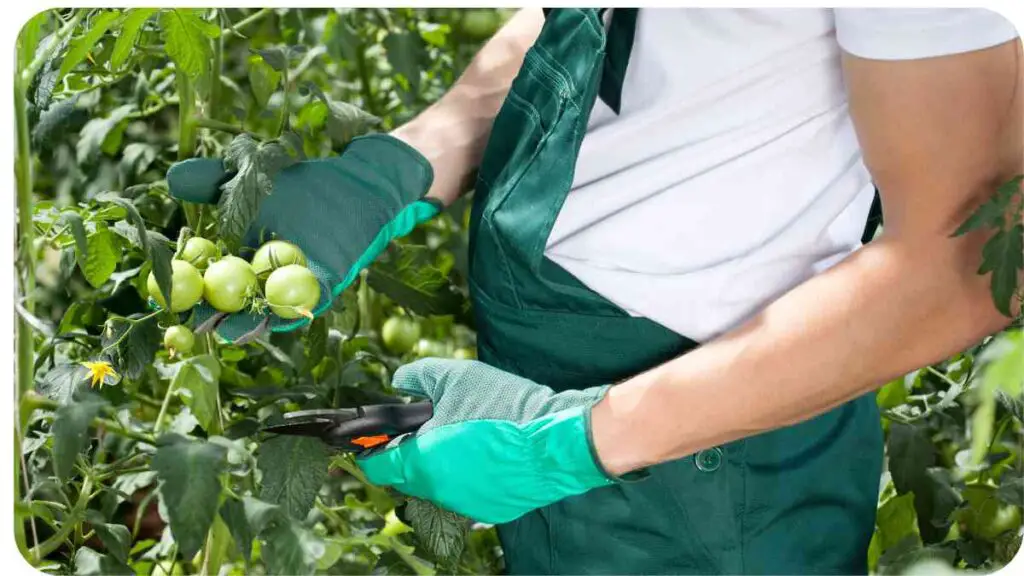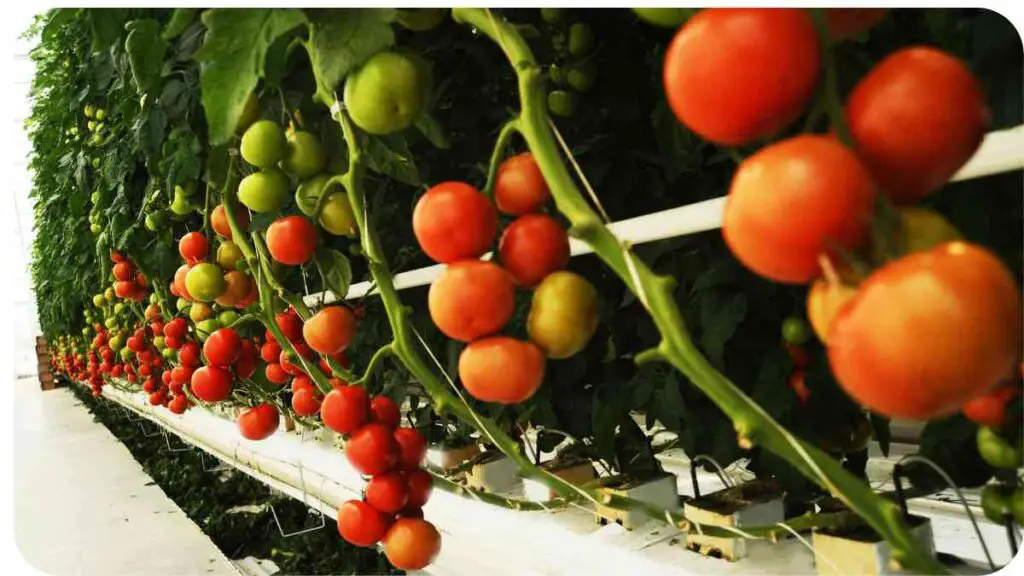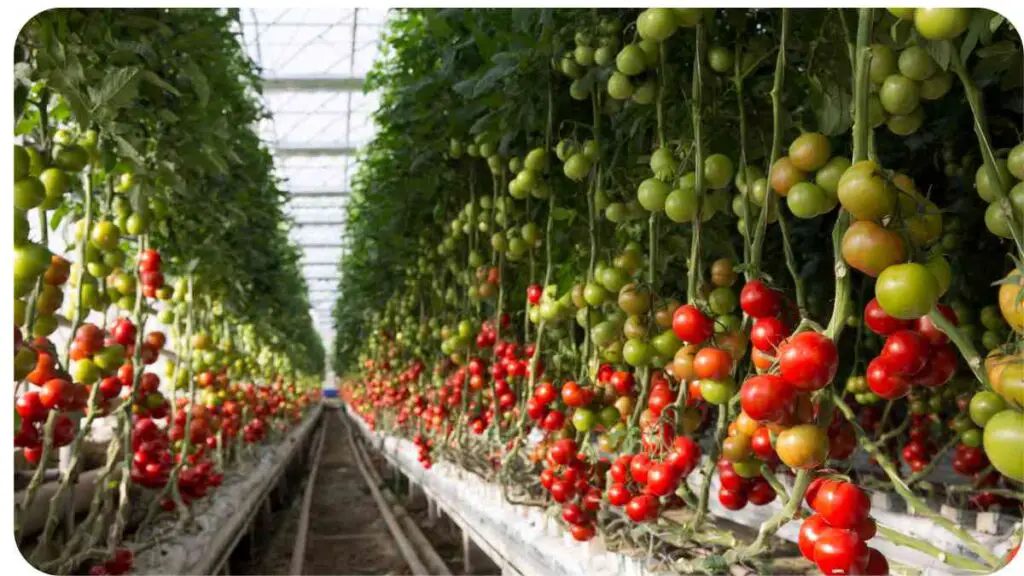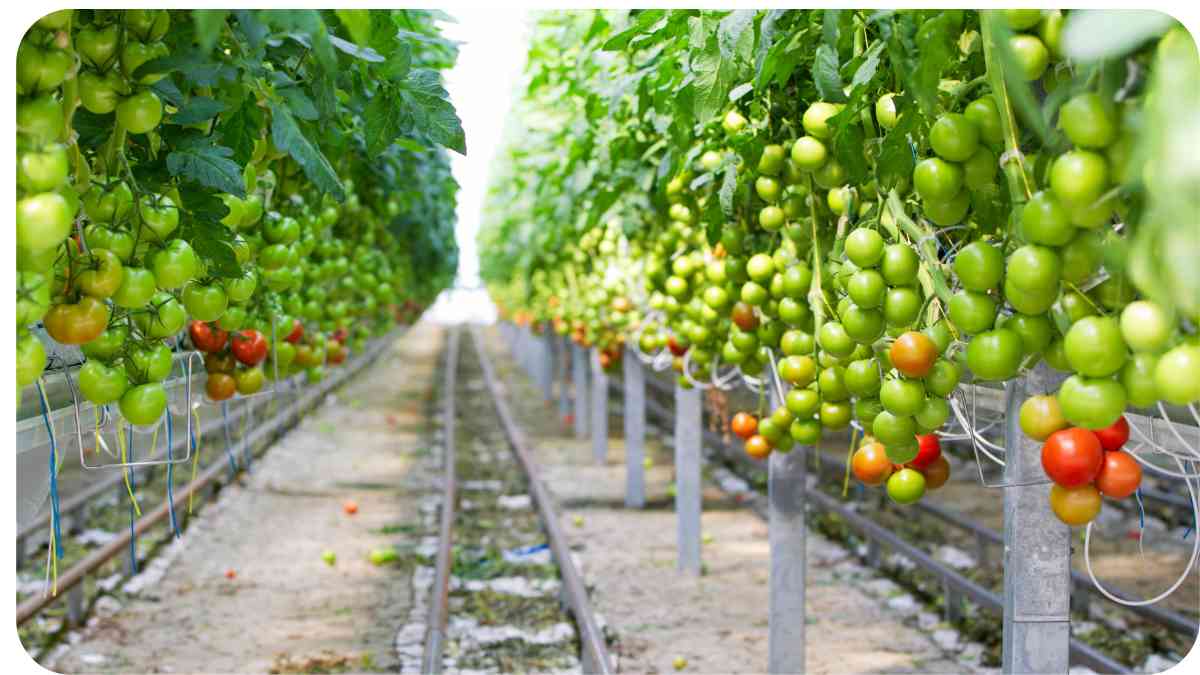Discover the art of optimizing cherry tomato yield in your hydroponic garden through effective pruning. Uncover essential techniques that enhance plant health, encourage robust fruit production, and navigate potential challenges.
This comprehensive guide delves into the intricacies of hydroponic cherry tomato pruning, providing both novice and seasoned gardeners with actionable insights for a thriving harvest.
For those looking to expand their hydroponic setup, our post on How Do You Build a Hydroponic Cloner? Easy Fix provides a comprehensive guide to building your own cloner, allowing you to propagate your plants with ease.
| Key Takeaways |
|---|
| Pruning is an important technique for promoting the health and productivity of tomato plants. |
| Regular pruning helps to improve air circulation, prevent diseases, and encourage the plant to focus its energy on producing fruit. |
| It is recommended to start pruning tomato plants when they reach 12-18 inches tall with 3-4 sets of true leaves. |
| When pruning tomato plants, remove any unnecessary branches or suckers, as well as any branches growing lower than the first fruit cluster. |
| Pruning can actually improve a tomato plant’s overall yield by directing its energy towards producing larger and higher-quality fruit. |
Our experts at Unified Garden are here to help you become a hydroponic gardening pro, so don’t hesitate to explore our blog and take your gardening skills to the next level.
The Main Stem Is Called A Leader
The main stem is called a leader. This is the main stem that will have the most fruit, leaves and height.
The leader will be the tallest stem on your cherry tomato plant. It can be as tall as 6 feet or more in some cases.
The leader will also have more leaves at its top than any other branch on your cherry tomato plant because it splits into multiple branches when it grows taller than 4 feet (1.2 meters).
The Main Stem: Understanding the Leadership Role
The main stem, often referred to as the leader, takes center stage in your cherry tomato plant. Functioning as the primary axis, it orchestrates the plant’s growth, bearing the highest yield, abundant leaves, and impressive height.
This commanding stem typically emerges as the tallest, occasionally reaching an impressive height of 6 feet or more. As it surpasses the 4-foot (1.2 meters) mark, the leader gracefully branches out, fostering a network of subsidiary stems. Notably, the upper region of the leader boasts a profusion of leaves, outshining all other branches. Explore the intricacies of this botanical leadership, where height, foliage, and fruitfulness converge.
“Properly using hydroponic nutrients is essential for maximizing plant growth and yield. Our guide on how to use hydroponic nutrients explains the importance of nutrient balance and how to adjust nutrient levels to meet your plants’ needs.”
Trimming the Tops: Promoting Growth and Airflow

Pruning the tops of cherry tomato plants serves multiple purposes in your hydroponic garden.
Firstly, it encourages the emergence of new stems, fostering a denser and more prolific growth pattern throughout the plant.
Secondly, by removing the upper portions of the plant, you create valuable space for neighboring plants and enhance overall air circulation within your garden environment.
Furthermore, the pruned leaves serve a dual function: acting as natural mulch to maintain optimal humidity levels while also mitigating the spread of diseases that may otherwise afflict your garden. Embrace the art of top pruning for a healthier, more vibrant hydroponic cherry tomato garden.
Elevating Growth: Pruning Low Branches for Vertical Vigor
In the pursuit of an upward-reaching cherry tomato plant, strategic pruning of lower branches becomes essential in hydroponic cultivation. Trim branches that exhibit horizontal or downward growth, as well as those veering away from the main stem.
By implementing this pruning practice, you not only facilitate a robust central leader but also safeguard against overcrowding within your hydroponic system. Embrace the precision of removing wayward lower branches to ensure the plant’s vertical ascent and foster an environment conducive to optimal growth in your hydroponic setup.
Ensuring Vitality: Pruning Dead or Diseased Foliage
Safeguard the health of your hydroponic cherry tomato plants by diligently cutting away any dead or diseased leaves and branches. Identifying dead leaves is straightforward—look for decay indicators such as brown or black spots, mold, or tissue holes during your examination.
Distinguishing diseased leaves may pose a challenge, as they can outwardly resemble healthy ones. On closer inspection, however, subtle signs of disease become apparent. Exercise precision in your pruning efforts, promptly removing any afflicted branches. Dispose of the diseased material safely to prevent the spread of ailments, ensuring the overall well-being of your hydroponic cherry tomato garden.
“Healthy roots are the foundation of a thriving hydroponic garden. Learn how to promote root growth in hydroponics with our expert tips on oxygenation, pH balance, and other important factors.”
Timing Matters: The Art of Pruning Precision

Exercise caution in pruning your hydroponic cherry tomato plants; timing is key to a successful harvest. Avoid the temptation to prune excessively in one session, as abruptly removing branches can traumatize the plant, delaying recovery.
Allow a minimum of two weeks after pruning for the plant to rebound and start producing new fruit. To expedite your harvest, refrain from cutting off all fruit-bearing branches simultaneously. Instead, adopt a gradual approach, removing one branch at a time until the desired pruning is achieved.
Pruning too late in the growing season poses serious risks, potentially jeopardizing the plant’s survival and eliminating the prospect of a fruitful harvest. Ensure your cherry tomato plants have ample time to produce a new crop before the onset of winter by adhering to strategic pruning practices. Timing, as they say, truly makes all the difference in cultivating a thriving hydroponic garden.
Nutrient Management: Pruning Competing Vines for Optimal Growth
Maintain the vitality of your maturing cherry tomatoes by proactively removing any vines that threaten to compete for essential nutrients. Left unchecked, these vines can pilfer nutrients from your developing fruit, compromising their growth.
Furthermore, should these vines proliferate and cast shadows over your maturing cherry tomatoes, they risk hindering proper ripening by obstructing sunlight. To counter this, promptly trim back excessive vines after a few weeks of growth. This proactive pruning approach ensures your cherry tomato plants receive ample sunlight, fostering ideal conditions for the development and ripening of your cherished fruit. Strike the right balance in your hydroponic garden to maximize nutrient utilization and promote robust fruit maturation.
“Lighting is a critical element in hydroponic gardening, but determining the right amount of light can be challenging. Our guide on how many lumens you need for hydroponics provides helpful information on the best lighting options and how to calculate your specific needs.”
Pruning Wisdom: Gradual Precision for Cherry Tomato Prosperity
Don’t prune too much at once. Start light, then go a little heavier next time you prune.
You’ll want to keep your cherry tomatoes healthy and productive, so it’s important to know when and how much to prune.
In general, you should start with lighter cuts and increase as needed throughout the season. Don’t prune too late in the season because doing so can stress out your plants and reduce their overall yield for that year.
You also shouldn’t prune too early in the year because this could make it harder for new growth and therefore fresh fruit to appear during the summer months.
A good rule of thumb is not to cut more than one branch per month from an individual plant; otherwise, you might end up depleting its energy reserve before harvest time comes around!
Year-Round Care: Nurturing Tomatoes Beyond Pruning

While the focus is often on pruning, it’s imperative to consistently care for your tomato plants to ensure their well-being.
Watering Wisdom: Maintain consistent watering for your tomatoes. Avoid over-watering, which can lead to root diseases and a yellow, limp appearance. On the flip side, preventing dehydration is crucial to thwart leaf spot and fruit skin cracking. Strive for a balanced watering approach to promote optimal plant health.
Fertilization Strategy: Choose a well-balanced fertilizer such as Dyna Gro Liquid Grow or Dyna-Gro’s All Purpose Plant Food. Apply it weekly at half strength throughout the growing season, adjusting as needed. As harvest approaches, consider slowing down growth to redirect energy toward larger fruits, enhancing the overall yield.
Temperature Considerations: Tomatoes thrive in warm weather year-round. If your region experiences cold winters with frost, consider relocating your plants to a porch. This simple step ensures continuous growth even in winter, with minimal care requirements beyond keeping the surroundings weed-free and maximizing exposure to daylight hours. By incorporating these practices, you’ll cultivate robust and resilient tomato plants throughout the seasons.
“Choosing the right hydroponic nutrients is crucial for healthy plant growth and maximizing yield. Check out our list of good hydroponic nutrients to ensure that you are providing your plants with the essential nutrients they need to thrive.”
Vigilant Monitoring: Post-Pruning Plant Check-In
After the pruning session, maintaining a vigilant eye on your cherry tomatoes is paramount. Regular checks ensure the continued well-being of your plants. Look out for the following indicators:
1. Signs of Disease: Thoroughly inspect for any signs of diseases. Keep an eye out for discoloration, unusual spots, or any abnormal patterns on the leaves or stems. Swift identification allows for prompt action to safeguard the overall health of your cherry tomato plants.
2. Signs of Insects: Be on the lookout for any signs of insect infestation. Check both sides of the leaves and stems for pests or any unusual activity. Early detection enables effective pest management strategies, preventing potential damage to your hydroponic garden.
3. Signs of Stress and Nutrient Deficiency: Monitor the foliage for signs of stress, such as yellowing leaves. Additionally, observe any indications of nutrient deficiency, which can manifest as changes in leaf color or texture. Adjust nutrient levels as needed to ensure your cherry tomatoes receive the essential elements for optimal growth.
4. Over- or Under-Watering: Evaluate the watering regimen and watch for signs of over-watering or under-watering. Wilting leaves can be indicative of both conditions. Adjust the watering schedule accordingly to maintain the right balance and prevent stress-induced issues.
Precision in Pruning: The Importance of Sharp Tools
Pruning tomato plants demands precision, and the choice of tools is pivotal to this process.
1. Clean and Disinfected Pruning Shears: Opt for a clean and disinfected pruning shear as your primary tool for cutting stems. It doesn’t have to be expensive; the key is its cleanliness and sharpness. A well-maintained pruning shear ensures a clean, precise cut, minimizing the risk of infection and promoting optimal healing for the plant.
2. Sharp Knife or Blade for Small-Scale Pruning: For smaller pruning tasks, a sharp knife or blade is a viable alternative. Ensure its sharpness and cleanliness to achieve clean cuts without causing unnecessary damage to the plant.
3. The Crucial Role of Sharpness: Above all, prioritize the sharpness of your pruning tools. Dull blades can tear through stems, causing more harm than good. A clean, sharp edge allows for smooth and efficient cuts, reducing stress on the plant and facilitating a quicker recovery.
“Building a recirculating hydroponic system can seem daunting, but with the right tools and guidance, it can be a fun and rewarding project. Our guide on building a recirculating hydroponic system offers step-by-step instructions and tips to help you create a successful system.”
Conclusion
In conclusion, the art of pruning cherry tomato plants emerges as a key contributor to their sustained health and productivity. Amidst various pruning techniques, our recommendation leans towards the Low Stress Training (LST) method.
By embracing the LST method, you not only unlock the potential for increased fruit production but also elevate the overall yield of your hydroponic garden. This strategic approach to pruning cherry tomatoes promotes a balance between plant vigor and fruitfulness, ensuring a bountiful harvest.
Make pruning an integral part of your gardening routine, employing techniques that align with the specific needs of your cherry tomato plants. As you master the nuances of pruning, witness the flourishing health and productivity of your plants, bringing the full potential of your hydroponic garden to fruition.
Further Reading
Here are some additional resources you may find helpful for pruning tomato plants:
Pruning Hydroponic Crops: This fact sheet from Oklahoma State University provides detailed information on pruning techniques for hydroponic tomato plants.
How to Prune Tomatoes: Wikihow’s guide on pruning tomato plants offers step-by-step instructions and helpful visuals.
Pruning Tomatoes: This guide from Fine Gardening provides tips and techniques for pruning tomato plants in both traditional and container gardens.
FAQs
What is pruning and why is it important for tomato plants?
Pruning is the process of selectively removing parts of a plant to improve its overall health and yield. For tomato plants, pruning helps to promote better air circulation, prevent diseases, and encourage the plant to focus its energy on producing fruit rather than foliage.
When should I start pruning my tomato plants?
It is generally recommended to start pruning tomato plants when they reach about 12-18 inches tall and have 3-4 sets of true leaves. This allows you to remove any unnecessary branches or suckers before they become too large and start to take away from the plant’s energy.
How many branches should I prune from my tomato plants?
The number of branches you should prune from your tomato plants depends on the type of tomato and the desired outcome. In general, it is recommended to remove any suckers that form in the crotch joint of two branches, as well as any branches that are growing lower than the first fruit cluster.
Will pruning my tomato plants reduce their overall yield?
While it is true that pruning can reduce the total number of branches and leaves on a tomato plant, it can actually improve the plant’s overall yield by directing its energy towards producing larger and higher-quality fruit.
Is pruning necessary for hydroponic tomato plants?
Pruning is important for all tomato plants, regardless of whether they are grown in soil or hydroponically. However, pruning techniques may vary slightly depending on the specific hydroponic system being used. It is important to research the appropriate pruning techniques for your specific system.

For 15 years, Hellen James has worked in the gardening industry as an expert and landscape designer. During her career, she has worked for a variety of businesses that specialize in landscaping and gardening from small firms to large corporations.

